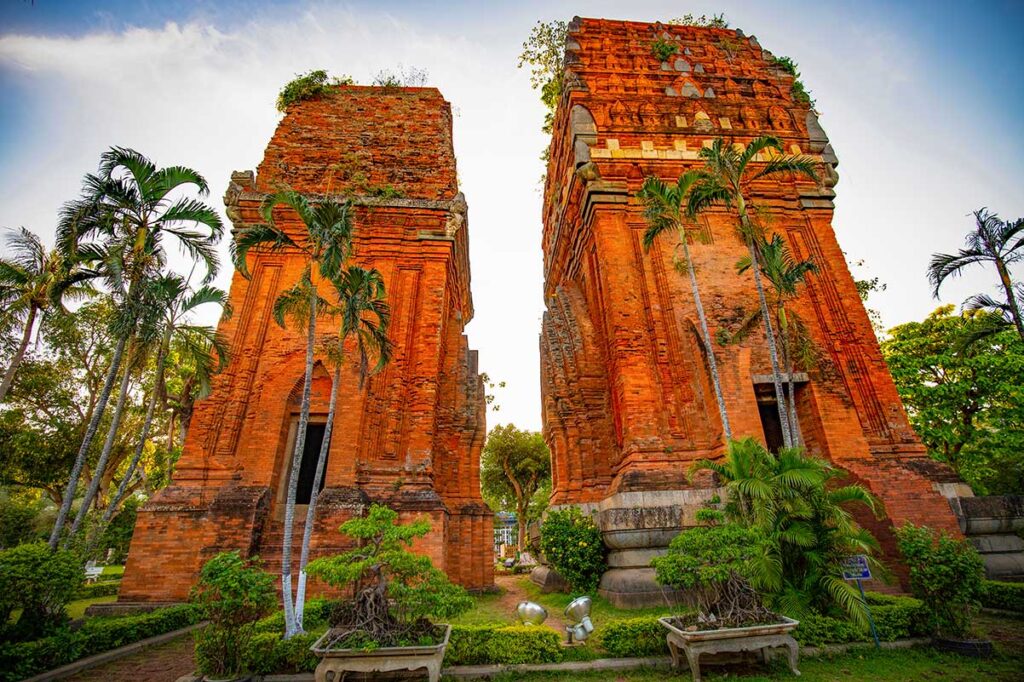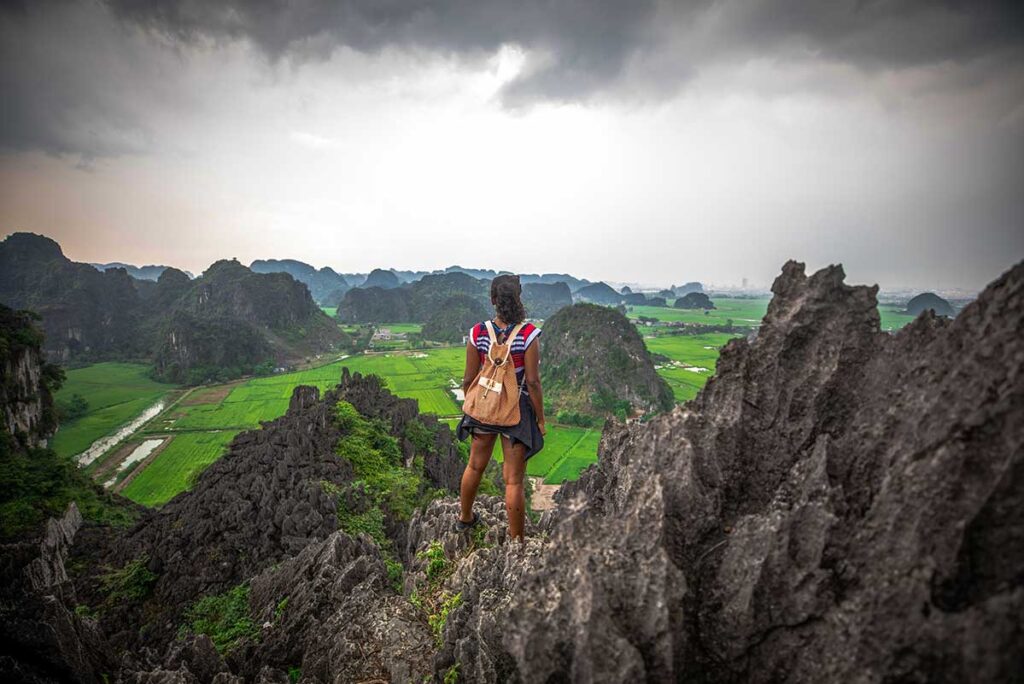What are the Cham Twin Towers?
The Cham Twin Towers (Tháp Đôi) are two brick temples from the Champa Kingdom, standing in the city of Quy Nhon. They are among the best-preserved Cham monuments in Vietnam and one of the easiest to visit, located just a short ride from the city center.

The Cham people once ruled large parts of central and southern Vietnam, strongly influenced by Hinduism and in contact with the Khmer Empire. These towers reflect that mix: Hindu-style temples built with Cham brickwork and Khmer-style decorative details such as Garuda bird figures and dancing motifs.
While they don’t take long to explore, the Cham Twin Towers are a clear window into the architectural skill and spiritual life of the Cham civilization that thrived here nearly 1,000 years ago.
History of the Cham Twin Towers
The Cham Twin Towers were built in the late 12th to early 13th century, during the height of the Champa Kingdom. Like many Cham religious monuments, they served as places of worship, most likely dedicated to Hindu deities such as Shiva or Ganesha, and in some cases also honoring deified Cham kings.
Architecturally, the towers show clear Khmer influence, a result of cultural exchange between Champa and the Khmer Empire at that time. Decorative Garuda statues brace the tower corners, while friezes of dancers and animal motifs once adorned the brickwork. Inside, a sandstone Linga–Yoni shrine symbolized fertility and divine energy, central to Cham Hindu rituals.
Originally, the complex included three towers, but one collapsed in the 19th century. The two surviving towers have undergone restoration, first in the 1960s and again between 1990 and 1995, when roof structures were reinforced using sandstone chosen to resemble the original materials. Visitors can still spot the difference between the ancient and restored sections.
Fragments of the lost third tower, including reliefs of dancers and carved door frames, are preserved and displayed at the Binh Dinh Museum, giving further insight into the artistry of Cham culture.
Highlights of visiting today
1. The towers themselves
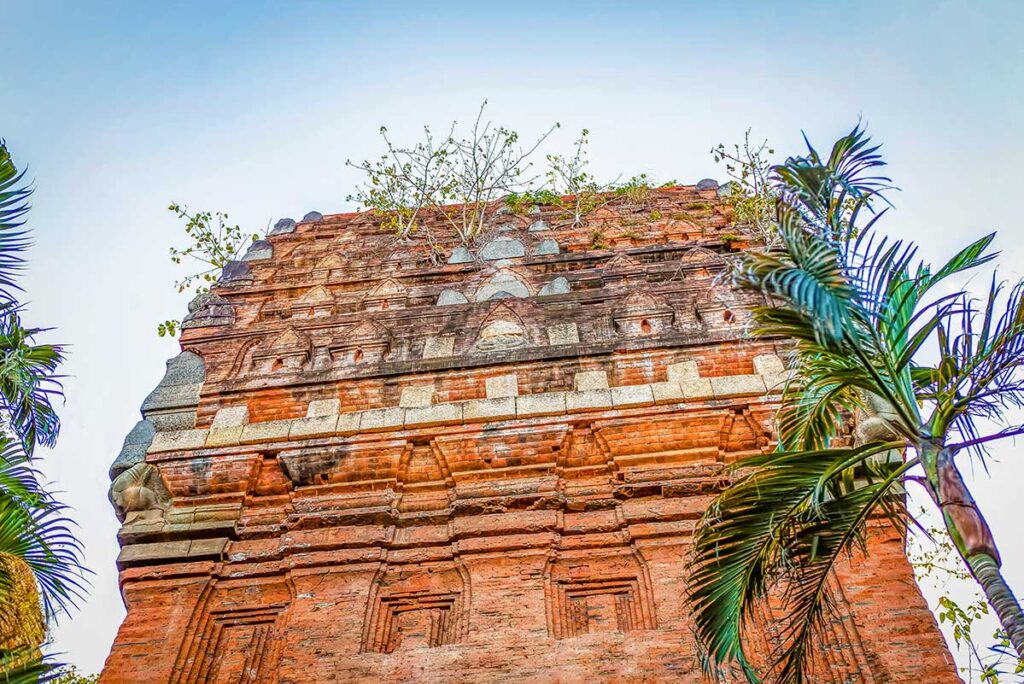
The complex consists of two towers: the larger one is about 25 meters high, while the smaller stands around 23 meters. Both are built of reddish-brown Cham bricks, fitted so tightly that the bonding method still puzzles researchers today.
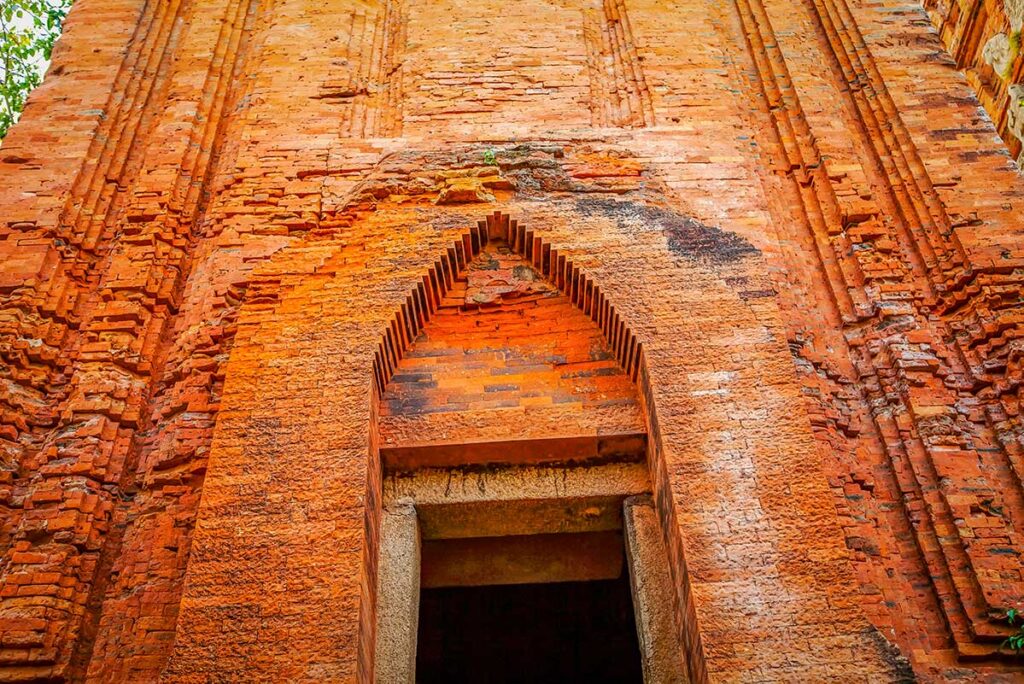
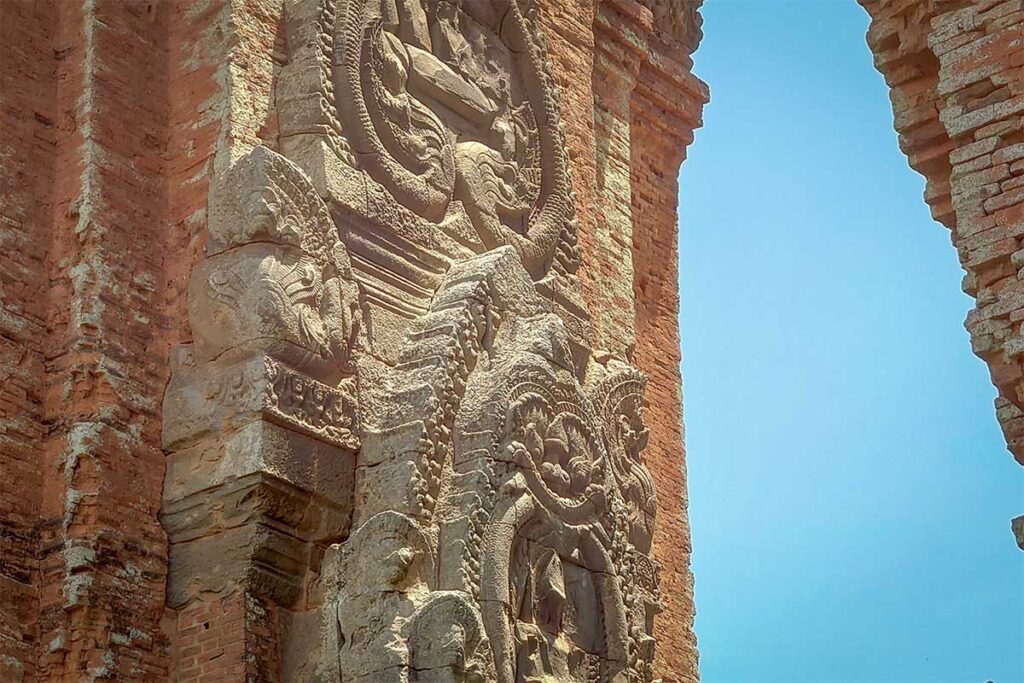
The walls once carried intricate carvings—dancers, deer, elephants, and Garuda bird figures—and you can still see traces of these decorative motifs on the exteriors.
Unlike many other Cham towers with three levels, these towers feature Khmer-style false tiers, giving them a slightly different silhouette compared to the rest of Binh Dinh’s Cham sites.
2. Cultural details inside
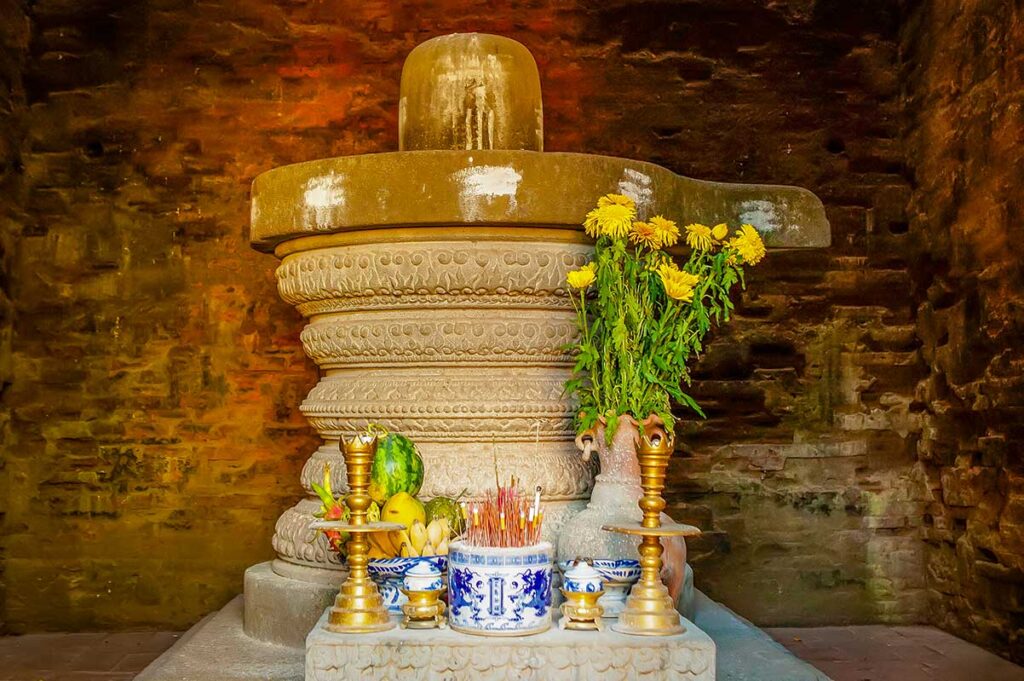
Inside, the towers once enshrined Linga–Yoni sculptures, central to Cham Hindu ritual practice. Some statues and friezes are still visible, including Garudas bracing the corners and fragments of animal motifs. Restoration work in the 20th century tried to match the original sandstone, but if you look closely, you can spot the difference between the ancient sections and the newer repairs. This contrast makes the towers a living example of both historic craftsmanship and modern conservation challenges.
3. Scenic views & Atmosphere
Set on slightly raised ground, the towers overlook surrounding farmland and patches of greenery. It’s not a high hilltop site like Banh It Towers, but the view still offers a calm break from the busy streets of Quy Nhon. The site is often quiet, with far fewer visitors than coastal attractions. The best light is early morning or late afternoon, when the sun catches the warm tones of the brickwork and the air is cooler.
4. Photography & Ao Dai rentals
The red brick towers framed by tropical greenery make for excellent photos, whether you’re interested in architectural details or wider scenic shots. At the entrance, you can rent a simple ao dai (traditional Vietnamese dress) for staged photos—a popular activity with locals and domestic tourists. While it may feel staged for some visitors, it’s a fun way to capture the sense of place and culture.
Location and Getting there
Where are the Cham Twin Towers?
The Cham Twin Towers are located about 3 km from Quy Nhon city center, at 1071 Trần Hưng Đạo Street. Their central location makes them one of the easiest Cham sites to visit in Binh Dinh. You can combine them with a walk around Quy Nhon or even a stop on the way to or from the airport.
Getting There by Taxi or Grab
The fastest option is to take a taxi or Grab car, which will only take around 10 minutes from most hotels in Quy Nhon. The visit itself doesn’t take long (30–45 minutes is enough), so you can ask the driver to wait if you like, or simply order another ride back.
Walking or Cycling
If you’re staying near the city center, it’s also possible to walk or cycle to the towers. Walking will take around 30–40 minutes, while cycling is an easy ride through the city streets.
Parking
If you go by motorbike or bicycle, there’s free parking available on site with plenty of space.
Practical information & Tips
Entrance fees
Tickets cost 20,000 VND per person (about $0.80). Parking for motorbikes and bicycles is free.
Opening times
The site is officially open from 7:00/7:30 am to 5:30/6:00 pm. Hours are not always strictly enforced, but don’t expect access outside these times.
Best time to visit
The towers are in an open area with very little shade, so it can get hot quickly. Morning or late afternoon is the most comfortable time and also best for photos.
Dress code & Etiquette
Although the site feels like an open park, these are still historic religious monuments. Wear respectful clothing that covers shoulders and knees if possible. At the entrance, you may find ao dai rental available if you’d like photos in traditional dress.
Facilities
There’s free parking and a staffed ticket booth. Occasionally an exhibition hall opens with some background information, but this is not always available. There are no cafés or shops inside the complex, so bring water if you’re visiting on a hot day.
Other Cham Towers around Quy Nhon
If the Twin Towers spark your interest, several other Cham sites in Binh Dinh are worth visiting:
- Banh It Towers – a larger hilltop complex about 20 km from Quy Nhon, with panoramic countryside views.
- Duong Long Towers – known for their intricate stonework and height, about 40 km away.
- Canh Tien Tower & Vijaya Citadel – historically significant ruins near the former Cham capital.
These make good half- or full-day trips if you’d like to see more of the Cham heritage in the region.
Are the Cham Twin Towers worth visiting?
The Cham Twin Towers are worth visiting if you’re already in Quy Nhon. They’re one of the most accessible Cham sites in Vietnam, and in just 30–60 minutes you can get a good feel for Cham architecture and history without leaving the city. The red-brick design, carvings, and cultural details make them interesting, especially if you enjoy historic monuments or photography.
That said, expectations should be realistic. The towers are compact, there isn’t much shade, and background music sometimes disrupts the atmosphere. Information on-site is limited, and while there are occasional quirks like bats inside one chamber, the visit is fairly straightforward.
Overall, this is a convenient and meaningful stop, best suited for travelers who appreciate cultural heritage and want more than beaches during their time in Quy Nhon. If you’re looking for scale and scenery, Banh It Towers or Duong Long Towers outside the city are more impressive, but Tháp Đôi stands out for its location and historical value.
